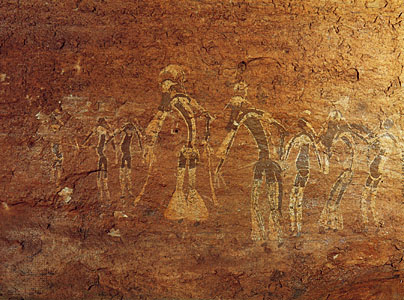Discovery
 It is likely that fire was first observed as a result of lightning or
volcanoes, rather than direct invention by hominids. There is evidence,
discovered in Kenya in 1981 and South Africa in 1988, that controlled use
of fire by hominids dates from c.1, 420,000 years ago. It is believed that
actual fire making techniques were only developed by Neolithic man c.7000
BC. Whilst earlier hominids would have maintained blazes caused by fortuitous
ignition, Neolithic man ignited fires with friction producing tools such
as drills or saws or with sparks generated from pyrite struck against flint.
It is not known how Neolithic man discovered ignition techniques, it is
supposed that the discovery was borne from observations such as the impact
of flint on pyrite caused a spark and that the actions of sawing or drilling
promoted heat. Flint, pyrites and fire drills have been recovered from
Neolithic sites in Europe. Even though Neolithic man had the ability to
ignite fires the techniques were still difficult and unreliable, especially
in damp conditions, and it was common practice to keep fires burning permanently
rather than re-ignite them.
It is likely that fire was first observed as a result of lightning or
volcanoes, rather than direct invention by hominids. There is evidence,
discovered in Kenya in 1981 and South Africa in 1988, that controlled use
of fire by hominids dates from c.1, 420,000 years ago. It is believed that
actual fire making techniques were only developed by Neolithic man c.7000
BC. Whilst earlier hominids would have maintained blazes caused by fortuitous
ignition, Neolithic man ignited fires with friction producing tools such
as drills or saws or with sparks generated from pyrite struck against flint.
It is not known how Neolithic man discovered ignition techniques, it is
supposed that the discovery was borne from observations such as the impact
of flint on pyrite caused a spark and that the actions of sawing or drilling
promoted heat. Flint, pyrites and fire drills have been recovered from
Neolithic sites in Europe. Even though Neolithic man had the ability to
ignite fires the techniques were still difficult and unreliable, especially
in damp conditions, and it was common practice to keep fires burning permanently
rather than re-ignite them.
 Rock painting of a dance performance, Tassili-n-Ajjer,
Algeria., attributed to the Saharan period of Neolithic hunters (c. 6000-4000
BC).
Rock painting of a dance performance, Tassili-n-Ajjer,
Algeria., attributed to the Saharan period of Neolithic hunters (c. 6000-4000
BC).
Back to the Welcome Page
 It is likely that fire was first observed as a result of lightning or
volcanoes, rather than direct invention by hominids. There is evidence,
discovered in Kenya in 1981 and South Africa in 1988, that controlled use
of fire by hominids dates from c.1, 420,000 years ago. It is believed that
actual fire making techniques were only developed by Neolithic man c.7000
BC. Whilst earlier hominids would have maintained blazes caused by fortuitous
ignition, Neolithic man ignited fires with friction producing tools such
as drills or saws or with sparks generated from pyrite struck against flint.
It is not known how Neolithic man discovered ignition techniques, it is
supposed that the discovery was borne from observations such as the impact
of flint on pyrite caused a spark and that the actions of sawing or drilling
promoted heat. Flint, pyrites and fire drills have been recovered from
Neolithic sites in Europe. Even though Neolithic man had the ability to
ignite fires the techniques were still difficult and unreliable, especially
in damp conditions, and it was common practice to keep fires burning permanently
rather than re-ignite them.
It is likely that fire was first observed as a result of lightning or
volcanoes, rather than direct invention by hominids. There is evidence,
discovered in Kenya in 1981 and South Africa in 1988, that controlled use
of fire by hominids dates from c.1, 420,000 years ago. It is believed that
actual fire making techniques were only developed by Neolithic man c.7000
BC. Whilst earlier hominids would have maintained blazes caused by fortuitous
ignition, Neolithic man ignited fires with friction producing tools such
as drills or saws or with sparks generated from pyrite struck against flint.
It is not known how Neolithic man discovered ignition techniques, it is
supposed that the discovery was borne from observations such as the impact
of flint on pyrite caused a spark and that the actions of sawing or drilling
promoted heat. Flint, pyrites and fire drills have been recovered from
Neolithic sites in Europe. Even though Neolithic man had the ability to
ignite fires the techniques were still difficult and unreliable, especially
in damp conditions, and it was common practice to keep fires burning permanently
rather than re-ignite them.
 Rock painting of a dance performance, Tassili-n-Ajjer,
Algeria., attributed to the Saharan period of Neolithic hunters (c. 6000-4000
BC).
Rock painting of a dance performance, Tassili-n-Ajjer,
Algeria., attributed to the Saharan period of Neolithic hunters (c. 6000-4000
BC).